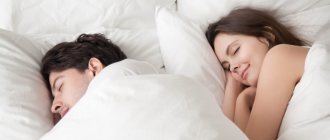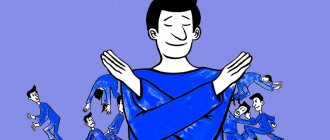If you manage yourself, you manage your life! This is an immutable truth, which is relevant in our time as never before, because the modern world is not only a world of high speeds and a huge number of things to do and worries, but also a world of stress and emotional instability, in which even the calmest person can easily get out of myself.
And today we will talk about mental self-regulation, thanks to which a person can learn to control himself, his manifestations and mental states. If this topic seems interesting to you, we advise you to pay attention to our course “Mental Self-Regulation”.
What is mental self-regulation?
Mental self-regulation is a person’s control of his psycho-emotional state, which is achieved through a person’s influence on himself through the power of words (affirmations), mental images (visualization) and control of breathing and muscle tone (relaxation). Self-regulation methods are used in absolutely any situation, and they always produce the desired effect.
Thus, among the effects of mental self-regulation, three main ones can be distinguished:
- Activation associated with increased psychophysiological activity
- Recovery associated with reduced symptoms of fatigue
- Calmness associated with the elimination of emotional tension
In general, there are, of course, natural methods of mental self-regulation, including:
- Music
- Dancing
- Movement
- Massage
- Interaction with nature and animals
- Food
- Dream
However, these funds cannot be used in many situations, for example, during work, when a person feels tired and observes tension in his mental state.
But it is precisely timely mental self-regulation that can be perceived as a psychohygienic means that can prevent the accumulation of overstrain, restore strength, normalize the psycho-emotional state and mobilize the body's resources.
For this reason, the most accessible methods of natural self-regulation are also:
- Expressing compliments, praise, etc.
- Breathing fresh air
- Real or imagined bathing in the sun
- Concentrating on pleasant things, photographs and flowers
- Contemplation of landscapes and panoramas
- Muscle relaxation, stretching and other similar movements
- Reflections on the pleasant and good
- Humor, smile, laughter, etc.
But, in addition to natural ones, there are special methods of self-regulation, which in some cases are also called self-influence. It is about them that will be discussed further.
Methodology
To clarify the patterns and features of self-regulation in everyday life, an empirical study was conducted in which respondents described their daily state and methods of regulating it. The survey involved 180 people of the middle age group, of different genders and professional backgrounds. Features of self-regulation of mental states in the daily cycle of everyday life were studied in two groups of subjects (20 people in each group, age 21–34 years). The first group is students, the second group is employees of a trading company. The subjects were asked to answer questions about negative mental states during the day (every hour) and ways to regulate them.
Methods of self-influence
So, methods of self-influence can be divided into:
- Related to verbal influence
- Movement related
- Breath-related
Let's look at each of them in more detail.
Methods of self-regulation associated with verbal influence
The impact of words is different in that it activates the conscious mechanisms of self-hypnosis. As a result, a direct effect on the psychophysiological functions performed by the body begins. As a rule, verbal self-suggestions are formulated through short and simple statements that do not use the particle “not.”
Verbal influence can be expressed in self-orders, self-programming and self-approval.
Self-orders
Self-orders are short and abrupt orders that a person gives to himself. A person should use self-orders when he is convinced that it is necessary to behave in a specific way, but there are some problems with organizing his behavior in this regard.
You should tell yourself something like: “Speak calmly!”, “Be silent, be silent!” or “This is just a provocation. Stop reacting!” - such self-importances will allow you to restrain your emotions and behave within the framework of decency, ethics and dignity.
You should work with self-orders like this:
- Self-order is formulated
- The self-command is repeated to oneself several times
- Self-order is pronounced out loud (if possible)
Self-programming
In some life situations a person needs to “look back”, i.e. Refresh your memory of past successes in similar situations. This can become an indicator that there are hidden volitional, intellectual, spiritual and even physical reserves in him, as well as indicate opportunities and give self-confidence.
You can set yourself up for success using self-programming. It is done like this:
- The person must remember a situation in which he has already successfully dealt with similar problems
- Then you need to use affirmation. To enhance the effect, you can give it the current tense, for example: “Now I can do this”, “Today I will be as confident as possible”, “Now I will be persistent as never before”, etc.
- After this, you should repeat the received affirmation several times (mentally, in front of a mirror, or simply out loud, if the situation allows)
Self-approval
Quite often, people cannot receive a positive assessment of themselves and their actions from the outside, which is very painful in situations with neuropsychic stress. A lack of positive evaluation can cause irritability, nervousness and even aggressiveness. For this reason, a person must encourage himself.
For self-approval or self-encouragement, you should simply say certain words to yourself, such as: “I’m super!”, “Well done!”, “Handsome!”, “Clever!”, “It worked,” etc.
Basic methods of self-regulation of mental and physical illnesses.
The problem of mental self-regulation is one of the most important and pressing problems of modern psychology. Its research opens up great, in many ways specific, non-traditional opportunities for understanding and meaningfully explaining the general patterns of a person’s construction and implementation of his activity in a real life environment (activities, behavior, adaptation to changed conditions of existence), for understanding the phenomenon of the general level of human subjective development, for research of individual typological features of human activity and behavior, in particular, orientation activity in changed conditions of existence, for productive participation in solving a wide range of practical problems.
An essential aspect of modern social life is the constant impact of stress factors on humans. In this case, the main problem is not the influence of stress factors themselves (since human existence is impossible without them), but their diversity in the nature of origin, duration and intensity of exposure, and specificity of reactions. The constant desire of humanity for progress complicates this diversity, which leads to the difficulty of predicting the appearance and development of stressful conditions in humans, since, as a consequence, there are also many of them (professional, informational, communication stress, etc.). In this regard, the study of stress resistance as a human ability to resist the negative influence of factors and the development of pathological conditions becomes important.
The study of the nature of stress resistance, ways and means of its formation and support is important for the individual in a number of life and professional events. In the process of work, a specialist systematically succumbs to psycho-emotional influences associated with excessive demands, a high level of control over production situations, limited resources and the possibilities of their change and improvement.
1. The concept of mental self-regulation
There are various definitions of self-regulation in the psychological literature. Let's look at some of them. Self-regulation (from the Latin “to put in order”, “to establish”) is the expedient functioning of living systems of different levels of organization and complexity. In relation to the environment, self-regulation is defined as an expedient, relatively corresponding to changing conditions, establishing a balance between the environment and the organism [2, 12]. In addition, self-regulation is the process of a person managing his own mental and physiological states, as well as actions and actions in relation to the real life environment. Mental self-regulation is one of the levels of regulation of the activity of living systems; it expresses the specificity of the mental means of reproducing and modeling reality that implement it, in particular reflection. It is realized in the unity of its energetic, dynamic and content-semantic aspects.
V.V. Nikolaeva defines mental self-regulation as a systemic process that ensures variability and plasticity of life activity at any of its levels adequate to the conditions [4; eleven]. S. Nikiforov understands this concept as a person’s conscious actions on inherent mental phenomena (processes, properties, states), the activities he performs, his own behavior in order to support (preserve) or change the nature of their course [4; eleven]. According to K.A. Abulkhanova-Slavsky [1], V.P. Boyarintsev [11], self-regulation can be
define how a mechanism for ensuring a person’s internal mental activity by mental means, while activity and self-regulation act as two complementary aspects: activity expresses variability, movement, and self-regulation ensures stability, stability of this activity. as defined by A.S. Romain [11], mental self-regulation is the regulation of various processes and actions of the body, carried out by the body itself with the help of its mental activity. Self-regulation as the body’s optimal adaptation to
N.I. understands the specific conditions of existence. Alexandrov [11]. Obviously, in this definition there is no subject that carries out regulatory actions. Self-regulation, in contrast to spontaneous activity, psychophysiological reactivity and activity, the control of which is determined by other people or circumstances, the situation, presupposes subjective activity, reflection and awareness of one’s own states, the reasons for their occurrence and the possibilities of change. A.P. Kornilov believes that the concept of self-regulation remains quite generalized, polysemantic, often “intuitively obvious”, despite the development of other concepts with the prefix “self” - self-esteem, self-attitude, self-knowledge [8]. L. G. Dikaya notes that in psychology the basic concepts of the theory of self-regulation, the level and components of its psychological system have not yet been clearly formed, the scheme of its psychological analysis and specific ways of its implementation have not been defined [8]. According to A.A. Konopkina [5; 6], the problem of mental self-regulation is one of the most global and fundamental problems of general psychology.
The concept of self-regulation is often found in scientific and other types of literature, is interdisciplinary in nature [7] and is characterized by ambiguity and a large number of interpretations. The term appears in a long synonymous series - “self-government”, “self-organization”, “self-regulation” and others. Often, authors do not provide a precise definition, and self-regulation turns out to be an “intuitively obvious” concept. Let us turn to the analysis of the concept of self-regulation presented in the scientific literature. S. Nikiforov writes that the addition of a pronominal adjective ZHE to one or another noun has a very specific meaning, the meaning of which is to indicate the direction of the action on the one who carries it out [4; eleven].
A.P. Kornilov, who assesses the development trend of the concept of self-regulation, indicates that self-regulation is understood as an analysis of the processes of meaning formation, including the level of self-reflection, the system of experiences in the context of self-identification [7]. He considers self-regulation to be a manifestation of the regulatory function of self-awareness.
I.A. Kudryavtsev and N.A. Ratinov note that the structural-functional model of conscious mental self-regulation proposed by A.A. Konopkin, is based on a one-sided idea of the specificity of regulatory processes in the human psyche [3; 7]. The model took into account the general principles of regulation in biological, social and technical systems - the target orientation and information tightness of the regulatory circuit, the presence of feedback, etc., but omitted some essential features of the determination of activity in the conditions of the human psyche. The way of human existence and purely human types of voluntary activity are determined not only through consciousness, but also through personality, as the prominent methodologists of psychological science wrote about - L.S. Vygotsky, S.L. Rubinstein, B.G. Ananyev, A.N. Leontyev, B.F. Lomov and others [9]. In this regard, pointing out the awareness of a person’s mental self-regulation is clearly not enough; the conceptual model needs to be supplemented with theoretical ideas about how the individual is involved in the process of self-regulation. Even information about the reproductive capabilities of human consciousness (mediation by collective experience, mental processes, etc.) and the specificity of its component composition are not able to compensate for the incompleteness of conceptual ideas about the role of the individual in the system of self-regulation. Consciousness is just the reproducing ability of the individual, acting as a subject.
Analysis of the relevant literature allowed us to determine the following forms of human self-regulation: voluntary (conscious) and involuntary (unconscious). Voluntary self-regulation is associated with target
activity, while involuntary is associated with life support, does not have specific goals and is carried out by a living being in the body on the basis of evolutionary norms that have developed. Self-regulation permeates all mental phenomena inherent in a person - from individual mental processes (sensation, perception, thinking, etc.) to managing one’s own states and skills to manage oneself. At a high level of development, it becomes a property of a person, a trait of his character, and it improves as a result of education and self-education. This also applies to the self-regulation of the subject’s social behavior.
Self-regulation is a closed loop of regulation and is an information process, the carriers of which are various mental forms of reality reproduction. Depending on the type of activity and the conditions for its implementation, it can be realized by various mental means: sensory specific images, ideas, concepts, etc.
1. Methods of mental self-regulation
Researchers include the main methods of mental self-regulation at the voluntary and conscious levels: autogenic training, neuromuscular relaxation, physical exercise, breathing techniques, the use of positive images (visualization), as well as methods associated with the influence of the word, its programming and regulatory role, etc. .d.
Autogenic training was proposed in the 30s. 20th century by the Austrian doctor I. Schultze. It is based on consistent self-suggestion of a feeling of heaviness and warmth in the extremities, then a feeling of warmth in the solar plexus, a feeling of warmth in the heart, and, finally, a feeling of a pleasant cool forehead. All these local phenomena promote relaxation, relieve nervous tension, and optimize recovery [3].
Autotraining is a method that combines elements of self-regulation and self-hypnosis. It consists of using independently, without outside help, learned or previously prepared suggestions in a state of deep relaxation (the so-called autogenic immersion) in order to create the necessary mental state. Auto-training helps a person manage his emotions, restore strength, maintain and improve performance, and relieve excessive mental stress. Typically, auto-training sessions last 20-30 minutes. It is recommended to do auto-training 2-3 times a day. Particularly effective workouts are in the morning, immediately after waking up and in the evening before bed. At this time, the cerebral cortex is slightly inhibited, which creates better conditions for self-hypnosis. You can completely master the exercise in 1.5 months [2].
Mental self-regulation includes the development of skills for managing attention, regulating the rhythm of breathing and muscle tone, operating with mental images and verbal formulas, and allows for targeted programming of one’s state and behavior. This is achieved by teaching a person to enter a special state of “autogenic immersion” of varying degrees. First, a state of relaxation is formed (reduction of tension, relaxation), which is characterized by a feeling of warmth, heaviness throughout the body, distraction from external stimuli, experiencing a state of peace, rest, inner carefreeness, elimination of anxiety, restlessness and normalization of autonomic dysfunctions. Based on relaxation, deeper stages of “autogenic immersion” are achieved, accompanied by a feeling of lightness, weightlessness of the body, and mobilization of internal freedom. This creates the prerequisites for the formation of states with high activity, performance and activity-based changes in consciousness with targeted volitional programming of one’s functional state and behavior [6]. The use of specially developed methods of mental self-regulation can reduce anxiety and restlessness, irritability, and conflict.
Effective methods of self-regulation, which are often used in combination with others, are methods associated with the influence of words, in particular, self-hypnosis, self-persuasion, self-order, self-approval (self-encouragement). Self-hypnosis is carried out by repeated repetition of words or certain verbal formulations. the formulation of self-hypnosis is constructed in the form of simple and short statements, with a positive orientation (without the particle “not”) [2; 3]. Self-persuasion is a kind of rational psychotherapy. It is carried out in conversations with oneself or with someone else. A self-order is a short, abrupt order made to oneself.
As a result of mental self-regulation, three main effects can occur: a calming effect (elimination of emotional tension), a restoration effect (weakening the manifestations of fatigue), and an activation effect (increasing psychophysiological reactivity) [8]. The integrated use of the considered methods, in our opinion,
improves the self-regulation system, thereby reducing maladaptive anxiety states. Combinations of self-regulation methods used
can be individual and unique. Thus, timely self-regulation acts as both a psychohygienic and psychocorrective means. It prevents the accumulation of excess overstrain phenomena, promotes restoration of strength, normalizes the emotional background, and enhances the mobilization of the body's resources.
Methods of self-regulation associated with movement
Mental stress initiates muscle tension – muscle tension. However, the ability to relax muscles can relieve neuropsychic tension and restore strength reserves in the shortest possible time.
In most cases, a person cannot relax all the muscles overnight, so it is recommended to focus attention on the most tense areas of the body.
The technique for effective muscle relaxation is as follows:
- You need to sit down and take a comfortable body position
- Then you should close your eyes and begin to breathe slowly and deeply.
- After this, you need to take an internal look at your entire body, starting from the top of your head and ending with your toes or vice versa, thus finding the most tense places (usually the stomach, shoulders, back of the head, neck, jaw, lips or mouth)
- The next step will be even stronger tension in the places of muscle clamps, up to trembling (you need to tense while inhaling)
- Now we need to try to feel the new tension
- And at the end you need to sharply relax (you need to relax while exhaling)
*This procedure must be repeated several times
If the muscle is relaxed really well, it will feel warm and pleasantly heavy. In the same case, if you can’t remove the clamp, you can try giving yourself a light massage on the tense area.
Methods of self-regulation associated with breathing
Breath control is a very effective means of influencing muscle tone and emotional brain centers. If you breathe slowly and deeply (abdominal breathing), the excitability of the nerve centers decreases, and a state of relaxation occurs. If you breathe exclusively through the chest, then the highest degree of activity of the body is ensured and neuropsychic tension is maintained.
Next, we present one of the simplest and most effective methods of respiratory self-regulation:
- You need to sit down, take a comfortable body position and focus on breathing
- While counting to four, you should take a deep and slow breath (use abdominal breathing)
- Then you need to hold your breath and also count to four.
- After this, you need to exhale smoothly, counting to six.
- Next, you need to hold your breath again, counting to four.
After just five minutes of doing this breathing exercise, you will notice that your state has become more balanced and calm.
Methods of mental self-regulation can and should be used daily at any moment when you begin to feel fatigue, tension, irritability, loss of strength, emotional decline and other similar conditions. In fact, such methods of influencing a person on himself are an excellent way to always be in a cheerful state and in a good mood, regardless of the characteristics of current situations.
YOUR WAYS OF SELF-REGULATION: Among other things, it is very interesting that each person has his own methods of mental self-regulation, i.e. those methods that suit him best. However, finding out which ones are effective and which ones are not very effective can be quite difficult - this requires a lot of practice and knowledge of the characteristics of one’s personality. But today we offer you an excellent opportunity to go through the first stage in a very short time and learn enough information about yourself to develop the most effective method of self-regulation for yourself, the use of which will serve you very well in life. This way is our course on self-knowledge, which you can find here.
Start self-knowledge, and we wish you good luck and always be in the best condition for yourself!
We also recommend reading:
- Storytelling
- Anger: causes and overcoming
- Eight Strategies to Improve Self-Regulation
- Ways to relieve stress
- Psychic reflection
- Methods of mental self-regulation: save yourself
- Common complexes and overcoming them. Part 2
- Systematic desensitization of Joseph Wolpe
- Emotional Intelligence in Leadership
- Anger management: a selection of useful materials
- The art of managing yourself
Key words:1Psychoregulation








